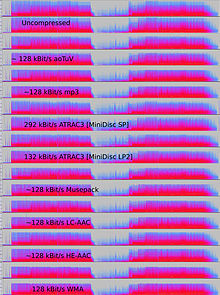Advanced audio coding
| Advanced audio coding | |
|---|---|
| File extension : |
.aac, .3gp, .mp4, .m4a, .m4b, .mpg, .mpeg
|
| MIME type : | audio / aac, audio / aacp, audio / mp4 |
| Developed by: | MPEG |
| Initial release: | 1997 |
| Type: | Lossy audio data compression |
| Contained in: | MPEG-2 (Part 7), MPEG-4 (Part 3) |
| Expanded to: | HE-AAC , HE-AAC v2 |
| Standard (s) : | ISO / IEC 13818-3: 1998 / Amd 1: 1999 ISO / IEC TR 13818-5: 1997 / Amd 1: 1999 ISO / IEC 13818-7: 1997 |
Advanced Audio Coding ( AAC ) is a lossy audio data compression method developed by the Moving Picture Experts Group (MPEG) , which was specified as a further development of MPEG-2 Multichannel in the MPEG-2 standard.
history
AAC is not based on the MPEG Layer 2 filter bank design like MPEG Layer 3 (MP3), but is a new development and, like Dolby Digital and Vorbis, uses the MDCT alone as the basic transformation. With less complexity than MP3, better quality can be achieved with the same data rate. Multi-channel coding is directly supported. Various "tools" are also supported; these are methods that are permitted in profiles with higher complexity in order to be able to encode critical signals better.
standardization
MPEG-2 (1997)

AAC was first standardized in 1997 in Part 7 of the MPEG-2 standard. Three profiles were specified for the new format. A profile is a standard within the format that precisely defines the coding and decoding methods used.
Profiles
- Low Complexity (LC): for medium to high bit rates. It is used in most AAC implementations (including hardware ) as well as Apple and RealNetworks' online music stores , and is the most widely used and supported profile to date. When AAC is used in common parlance, it usually refers to this special format. As a container format , however, MPEG-2 has largely been replaced by the newer MPEG-4 ( file extension .m4a or .mp4).
- Main Profile (Main): like the LC profile, but supplemented with backward forecast
- Scalable Sample Rate (SSR): for streaming. It enables the undisturbed playback of streams by reducing the bit rate if the available bandwidth suddenly drops, but is not yet publicly available in any implementation.
MPEG-4 (1999)
In 1999, AAC was included in the new MPEG-4 standard in Part 3 (also known as MPEG-4 audio) and there in turn in Subpart 4 (General Audio Coding). The new standard categorizes its various audio formats in so-called object types. The original version of AAC, combined with the new Perceptual Noise Substitution procedure , was included in the Main profile as object type 1 and in the Low Complexity (LC) profile as object type 2. Some optional extensions of the original format have been defined as further object types:
- Low Delay (LD): For short delay times (20 ms) at medium to high bit rates. Application in the communication sector, for example in video conference systems.
Profiles
The MPEG-4-Part-3 standard defines so-called profiles, which are a combination of several object types. The following is a selection of the most important profiles that contain AAC.
- HE-AAC (High-Efficiency AAC), also known as AAC + or aacPlus : Combines the object types AAC LC and SBR ( Spectral Band Replication ). HE-AAC is optimized for use with low bit rates (in the range 32–80 kbit / s) and scores better than normal AAC in hearing tests in this range.
- HE-AAC v2 , also known as eAAC +, AAC + v2 or aacPlus v2: Like HE-AAC, but also with the object type Parametric Stereo (PS). This compression process is optimized for even lower bit rates (16–40 kbit / s) and should still achieve an acceptable quality in this area.
HE-AAC and HE-AAC v2 are extensions of the original AAC, but do not replace it. They are optimized exclusively for low bit rates and are used, for example, for live broadcasts on digital radio and television. At higher bit rates (from 96 kbit / s) they do worse than AAC and should therefore not be used.
Importance and distribution
As a lossy audio compression format adopted by the ISO as a standard, it competes with other formats such as MP3 , WMA and Vorbis . AAC already achieves an acceptable, albeit limited, stereo quality from 64 kbit / s. 96 kbit / s correspond to good FM quality, and 128 kbit / s already have a high level of transparency . Bit rates from 192 kbit / s or 224 kbit / s are comparable to the low-loss CD format (1,411 kbit / s). AAC is used wherever MP3 is normally used. This is why more and more MP3 players , music websites and Internet radios are using this audio compression. The video container formats 3GP , MP4 , MPEG-2 and other formats also support AAC. When Digital Radio DAB + AAC is also used.
Licenses and Patents
Manufacturers of an implementation of AAC must purchase a license. For this reason, free software that implements the codec is often only distributed in the source code to avoid patent infringement.
See also
literature
- Roland Enders: The home recording manual. The way to optimal recordings. 3rd, revised edition, revised by Andreas Schulz. Carstensen, Munich 2003, ISBN 3-910098-25-8 .
- Thomas Görne: Sound engineering. Fachbuchverlag Leipzig in Carl Hanser Verlag, Munich et al. 2006, ISBN 3-446-40198-9 .
Web links
- Description of the MPEG-2 standard (English)
- Licensing issues: Via Licensing Corporation - Advanced Audio Coding (AAC )